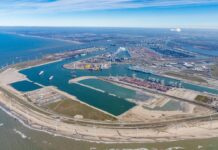The construction of the new sea lock in IJmuiden has been delayed by 27 months. A major setback, but the decision to postpone the completion date was not taken lightly. New insights into the design and construction of the caissons and the construction of the lock gate chambers of the new sea lock made it necessary to adjust the planning. Prudence is paramount.
“We imagined it would be quite shock to announce the news last December and the delay of 27 months that we had to report recently may even have been harder to stomach”, Jaap Zeilmaker, Project Director at Rijkswaterstaat (the Department of Public Works and Water Management), began. “Despite this news, the construction of the new sea lock is continuing unabated”. At the moment, OpenIJ is busy with the construction of the walls of the lock gate chambers and the lock chamber walls, while the construction of the lock gates in South Korea is entering its final stage. The gates are expected to arrive in the Netherlands by the end of this year.
Large Size
In their December reports, BAM and VolkerWessels stated that they had come to new conclusions regarding the robustness of the caissons. These caissons will later be used as lock gate chambers to store the gates in open position. The caisson method is not unknown. The pillar foundation of the Erasmus Bridge in Rotterdam and the lock head of the sea lock at Barrow-in-Furness are recent examples of structures that have been built with the caisson method. “But the caisson method has not been used earlier for structures as big as the gate chambers at the new sea lock at IJmuiden. The inner head, which will be used to install two lock gates instead of one, will be 80 by 55 metres”, Zeilmaker explained. “With a height of 23 metres, it is as if a large building is going to be sunk into the ground and because there are a number of risks involved, we first needed to test this construction method for technical feasibility. These tests were carried out by an independent committee”.
Extra work
The independent committee indicated that the caisson method on this scale was technically feasible, provided a number of precautionary measures were taken. Zeilmaker added, “One of the measures we needed to take was to install auxiliary structures that would make the caisson stiff enough. This was to ensure that during the sinking operation the caisson would not get damaged or deformed. These auxiliary structures, which are also huge in size, will have to be demolished after the caisson has been sunk to its final depth. All in all, this meant a lot of extra work that was not foreseen.”
Interconnected activities
The caissons are very decisive factors in relation to other construction activities. “As long as the caissons sit high and dry on the land and the lock gate chambers are not completed, we cannot install the lock gates in the lock. So then it becomes impossible to test the new sea lock and open it to shipping. Each and every link in the construction chain must be joined together to form a single chain”, Zeilmaker explained.
Taking risks into account
Rijkswaterstaat and OpenIJ took no chances when mapping out the consequences of this delay on the planned completion date. Zeilmaker continued: “First, OpenIJ made a meticulously calculation of all planned construction activities and of the way they influence each other. We then had this construction planning tested by independent experts for feasibility and realism. Of course we knew how difficult a project of this size was and therefore it was not only important to list all our construction activities in chronological order, but also to take into account the risks that could occur during the various construction phases”. That is why Rijkswaterstaat is now using a new planning schedule with a new delivery date at the end of January 2022 – in line with the independent experts’ advice.
No need for a longer road closure
Many people have asked if the delay of 27 months also meant that the public road across the lock complex will remain closed for a longer period of time. “We think that the new planned completion date of the lock will not necessarily mean a longer road closure, but the problem is that we cannot reopen this public road until it is absolutely safe to do so”, Zeilmaker explained.








